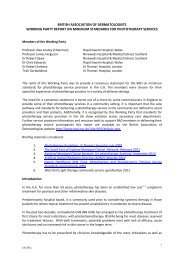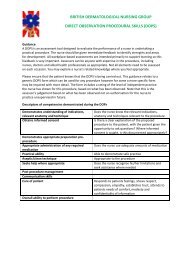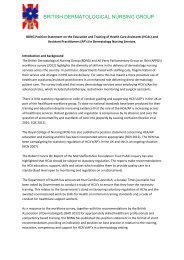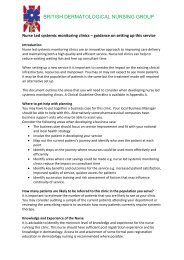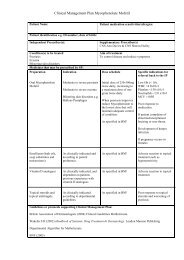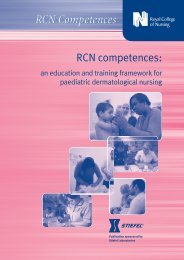Improving outcomes for people with skin tumours including melanoma
Improving outcomes for people with skin tumours including melanoma
Improving outcomes for people with skin tumours including melanoma
You also want an ePaper? Increase the reach of your titles
YUMPU automatically turns print PDFs into web optimized ePapers that Google loves.
<strong>Improving</strong> Outcomes <strong>for</strong><br />
People <strong>with</strong> Skin Tumours<br />
<strong>including</strong> Melanoma<br />
Follow-up<br />
One observational study found that the interval between primary and<br />
recurrent BCC ranged from 2 to 12 years, <strong>with</strong> no definite correlation<br />
according to histological type of BCC. The authors concluded that all<br />
patients <strong>with</strong> excised primary BCC should be followed up <strong>for</strong> at least<br />
3 years.<br />
Squamous cell carcinoma<br />
The BAD guidelines strongly recommend that self-examination is an<br />
important aspect of continued care and these recommendations are<br />
supported by a review of the current evidence.<br />
5<br />
One systematic review found that the local recurrence rates in patients<br />
<strong>with</strong> SCC range from 1.3% to 10%, across the different treatment<br />
modalities. Of those SCCs that recur, 58% do so <strong>with</strong>in the first year of<br />
follow-up and 95% do so <strong>with</strong>in the first 5 years of follow-up. The<br />
metastatic rate of primary SCC on sun-exposed sites ranges from 2.3%<br />
to 5.2%. The maximum period of follow-up was five years. Of those<br />
SCCs that metastasise, 69% do so <strong>with</strong>in 1 year of follow-up and 96%<br />
do so <strong>with</strong>in 5 years of follow-up. The review concluded that patients<br />
<strong>with</strong> SCC should have lifetime follow-up, in order to detect<br />
recurrence, metastasis and new primary <strong>skin</strong> cancers.<br />
One observational study found the mean duration between excision<br />
and metastasis to be 10.3 months. The rate of metastasis was 2%<br />
overall and the authors suggested that follow-up of patients be<br />
maintained <strong>for</strong> at least 2 years after treatment.<br />
Melanoma<br />
All patients who have a diagnosis of invasive MM are at risk of<br />
recurrent disease and there<strong>for</strong>e doctor- or nurse-based follow-up is<br />
worthwhile. Although the risk can be predicted by a variety of<br />
independent risk factors, such as sex, ulceration and site, the single<br />
most commonly used predictor is the Breslow thickness. An inverse<br />
relationship is recognised between Breslow thickness and disease-free<br />
interval. There is, however, increasing evidence that the results from<br />
SNB are a better predictor of survival. SNB is an invasive procedure<br />
<strong>with</strong> potential morbidity; decisions to undertake SNB should only be<br />
made after careful consideration and only in the specific<br />
circumstances set out in the ‘Initial investigation, diagnosis, staging<br />
and management’ chapter.<br />
108<br />
National Institute <strong>for</strong> Health and Clinical Excellence




